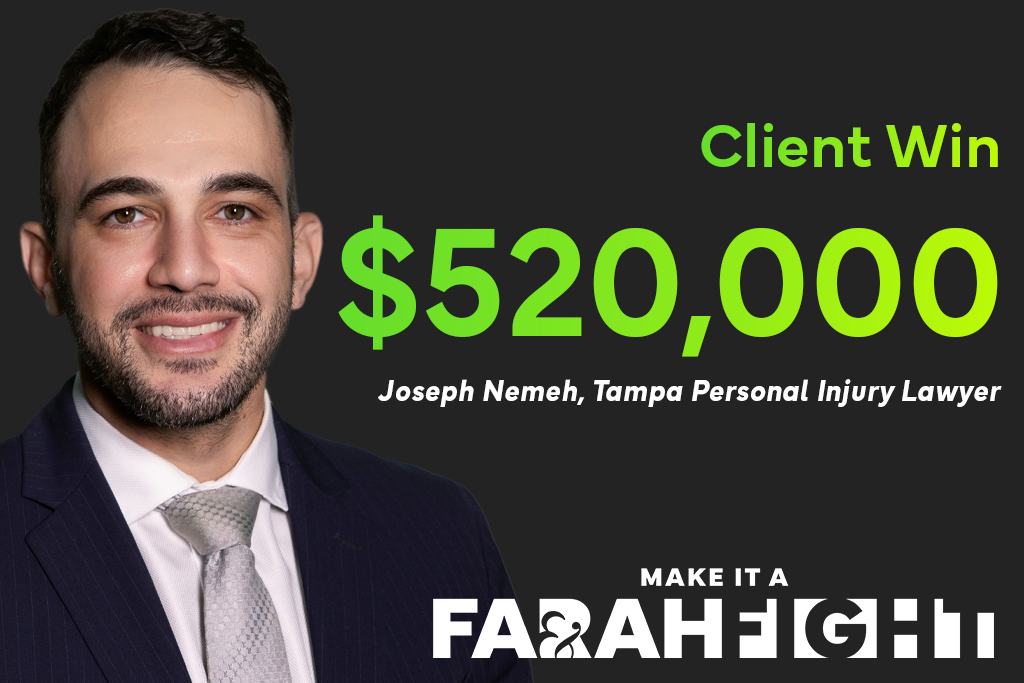One quick stop inside a Tampa furniture store turned into months of pain when an unmarked spill sent our client to the floor—on camera. With clear video evidence and a medical history that the defense tried to weaponize, Farah & Farah’s team in Tampa, Florida, cut through the noise, moved the conversation from a $75,000 opening offer to a $520,000 settlement, and gave her the space to heal.
The Fall Inside the Store
Our client visited a Tampa furniture store and, on the way to the restroom, encountered an unmarked liquid spill near the back of the showroom. She slipped and fell hard. The store’s surveillance video clearly captured the moment, showing a hazardous condition that should have been found and fixed. When she came to Farah & Farah for help, it was immediately clear that the footage would anchor liability. What was not simple was the medical picture that followed and the task of proving how this single fall changed her health, her work, and her daily life.
Early Case Intake and Investigation
From day one, attorney Joseph Nemeh and our Tampa-based team at Farah & Farah set the pace for the investigation, coordinating closely with providers and keeping each step documented and time-stamped. Working diligently, Joseph and his team secured the incident report and preserved the surveillance footage, so no one could later dispute what the camera already showed. Interviews with staff and our client helped place each detail in context. By the time formal discovery began, we had a tight story supported by documents, timestamps, and the store’s own video.
Injuries and Treatment Following the Fall
The fall caused injuries to multiple areas of our client’s body. She sustained cervical and lumbar disc herniations that produced radiating pain and stiffness. Her left knee suffered a torn ACL, and her right knee had a partial meniscus tear. Her right wrist showed a partial tear that made ordinary tasks difficult. Treatment began conservatively with diagnostic imaging and targeted injections to the back, knee, and wrist.
As our client’s injuries and pain persisted, her providers escalated to radiofrequency ablations to quiet the nerve pain and delay surgery as long as possible. She remains a candidate for surgical fusion in the spine if symptoms worsen. Even without surgery, the projected cost of neck and back care alone has been estimated between two hundred and three hundred thousand dollars, and that figure does not include the ripple effects of missed work and day-to-day limitations. Throughout this process, we emphasized objective findings and a consistent course of care because juries and insurers alike respond to records that show a steady, necessary medical path.
Distinguishing Pre-Existing Conditions From New Injuries
A second challenge complicated the case. Just weeks before the store incident, our client had been in a serious motor vehicle crash that another firm had resolved quickly for her. When she came to us after the store fall, we knew the defense would try to blur the lines and blame everything on the car crash.
Joseph and his team knew they needed to answer that strategy with careful, patient work. Every medical record was thoroughly reviewed, lining up details from before and after the fall. By comparing symptom reports across visits and linking each diagnosis, prescription, and therapy session to the incident most consistent with the medical evidence, Joseph forged a causal timeline. This timeline separated the prior accident from the harm that followed this fall, becoming the backbone of negotiations.
Video Evidence That Shifted Leverage
Slip-and-fall cases do not always come with clear footage. Here, the store’s video showed exactly what happened. The defense sought to delay producing the file until after our client’s deposition. We pushed back because the footage was central to the truth and because rules require timely production.
With the video footage, any question of liability was removed. The focus moved to the true issues in dispute: the extent of the injuries, the reasonable cost of care, and the long-term impact on our client’s life. Having that visual anchor reduced the noise and allowed us to build value on a foundation the defense could not erode.
Handling Discovery Hurdles and Delays
As discovery progressed, we encountered the usual friction. Certain disclosures arrived late. Some interrogatory answers were incomplete. We answered delays with motions when necessary and always with persistence. Along the way, we supplemented our own work with updated medical records, billing ledgers, and treating provider narratives.
We also prepared our client for deposition by walking through the medical chronology in plain language so she could testify truthfully and confidently without getting lost in dates or jargon. When the defense scheduled independent medical examinations, we made sure the examiners had the whole record, not selective pieces that could distort the evaluation.
Leadership From Our Tampa Team
Under the leadership of attorney Joseph Nemeh, our Tampa, FL-based team coordinated closely with providers and kept the case’s medical timeline crystal clear. Grounded in the facts and the record, Joseph kept negotiations focused on the evidence—what the video showed, what the imaging confirmed, and what our client’s treatment required—rather than speculation or distraction.
Negotiating From $75,000 to $520,000
We opened with a data-driven demand slightly above five hundred and fifty thousand dollars. The insurance company answered with a seventy-five thousand dollar offer that did not account for the medical complexity or the reality of possible future surgery. We held to our valuation because it was grounded in evidence rather than guesses. As more records arrived and expert opinions took shape, the defense began to recognize the risk of taking the case further.
The parties moved through several rounds of negotiation. Each time we engaged, we returned to the same pillars. The store had a duty to keep customers safe. The fall happened because a hazardous condition was not found and fixed. The medical record showed a consistent path of treatment. The cost of that care was real and would continue. The case ultimately resolved for five hundred and twenty thousand dollars, reflecting the strength of the evidence and the clarity of the medical timeline we built.
What This Result Means for the Client
A settlement cannot erase pain, but it can give space to heal. For our client, this outcome pays down substantial medical expenses and creates a margin for future care if symptoms flare or surgery becomes necessary. It reduces the pressure of choosing between appointments and paychecks. It recognizes the daily realities of living with spine and joint injuries.
Most importantly, it affirms what the evidence showed from the beginning. There was a dangerous condition inside the store, and the harm that followed was real and significant. With accountability secured, our client can focus on recovery rather than arguments over what should have happened on that showroom floor.
Lessons for Store Safety and Accountability
Cases like this matter beyond a single incident. When retailers quickly identify hazards and act on them, customers are safer, and claims are rare. When they do not, the consequences can be life-changing. Surveillance cameras, inspection logs, and cleanup protocols exist for a reason. They are not just paperwork to file away. They are the everyday tools of prevention. This case underlines the value of taking those duties seriously.
We Will Help You Seek the Justice You Deserve
At Farah & Farah, we bring the same focus to every case we handle. We listen first. We explain options in plain language. We gather the evidence that tells your story honestly and completely. If you or a loved one was hurt at a store, restaurant, or other business, you do not have to face the insurance company alone. Reach out for a free consultation at any time for help. You won’t have to pay anything unless we win.










